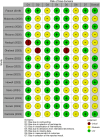Clinical outcomes of kinematically aligned medial pivot total knee arthroplasty: A systematic review and meta-analysis of current evidence
- PMID: 40655242
- PMCID: PMC12255947
- DOI: 10.1002/jeo2.70348
Clinical outcomes of kinematically aligned medial pivot total knee arthroplasty: A systematic review and meta-analysis of current evidence
Abstract
Purpose: Kinematic alignment (KA) in total knee arthroplasty (TKA) focuses on restoring the natural joint line and ligament balance, potentially improving biomechanics and outcomes over mechanical alignment (MA). The medial pivot (MP) implant enhances joint stability by mimicking physiological knee motion. Still, its role within a KA protocol and the effects of retaining versus sacrificing the posterior cruciate ligament (PCL) are unclear. This study aimed to evaluate the clinical effectiveness, functional outcomes and biomechanical benefits of KA-TKA with MP implants based on the available literature. It also aimed to assess whether PCL retention or sacrifice leads to better postoperative function.
Methods: A systematic review and meta-analysis were conducted following PRISMA guidelines. A comprehensive search of PubMed, Embase and Web of Science up to January 2025 identified studies assessing KA-TKA with MP implants. Primary outcomes included patient-reported outcome measures (PROMs), range of motion (ROM), complication rates and implant survivorship. Subgroup analysis compared PCL retention and sacrifice.
Results: Fourteen studies (955 patients) met inclusion criteria. KA-TKA with MP implants resulted in significant ROM improvements (+11.35°, increased to +12.50° after sensitivity analysis) and enhanced PROMs (Oxford Knee Score +18.23, increased to +22.27 after sensitivity analysis; Knee Society Score [KSS] +49.61, functional KSS +42.50). No aseptic loosening or implant failures were reported. PCL sacrifice was associated with greater postoperative flexion (125.4° ± 12.1° vs. 116.4° ± 11.8°, p < 0.001), but functional outcomes were comparable.
Conclusions: KA-TKA with MP implants improves functional recovery, patient satisfaction, and short- to mid-term survivorship, supporting its adoption as a viable alternative to conventional TKA. Further long-term, randomized trials are needed to optimize PCL management and confirm its durability.
Level of evidence: Level IV.
Keywords: biomechanics; kinematic alignment; medial pivot; posterior cruciate ligament; total knee arthroplasty.
© 2025 The Author(s). Journal of Experimental Orthopaedics published by John Wiley & Sons Ltd on behalf of European Society of Sports Traumatology, Knee Surgery and Arthroscopy.
Conflict of interest statement
The authors declare no conflicts of interest.
Figures








Similar articles
-
Retention versus sacrifice of the posterior cruciate ligament in total knee arthroplasty for treating osteoarthritis.Cochrane Database Syst Rev. 2013 Oct 11;2013(10):CD004803. doi: 10.1002/14651858.CD004803.pub3. Cochrane Database Syst Rev. 2013. PMID: 24114343 Free PMC article.
-
Kinematic Alignment Does Not Result in Clinically Important Improvements After TKA Compared With Mechanical Alignment: A Meta-analysis of Randomized Trials.Clin Orthop Relat Res. 2025 Jun 1;483(6):1020-1030. doi: 10.1097/CORR.0000000000003356. Epub 2025 Jan 21. Clin Orthop Relat Res. 2025. PMID: 39842026
-
Posterior Cruciate Ligament Retention Does Not Influence Clinical Outcomes in Medial Pivot Total Knee Arthroplasty: A Systematic Review and Meta-Analysis.J Arthroplasty. 2025 Jun 3:S0883-5403(25)00623-0. doi: 10.1016/j.arth.2025.05.100. Online ahead of print. J Arthroplasty. 2025. PMID: 40473054
-
No Difference in 10-year Clinical or Radiographic Outcomes Between Kinematic and Mechanical Alignment in TKA: A Randomized Trial.Clin Orthop Relat Res. 2025 Jan 1;483(1):140-149. doi: 10.1097/CORR.0000000000003193. Epub 2024 Aug 14. Clin Orthop Relat Res. 2025. PMID: 39145997 Clinical Trial.
-
Influence of Total Knee Arthroplasty Alignment on Soft-Tissue Balance and Pivot Patterns: A Randomized Controlled Trial of Kinematic Versus Mechanical Alignment.J Arthroplasty. 2025 Jun 5:S0883-5403(25)00662-X. doi: 10.1016/j.arth.2025.05.128. Online ahead of print. J Arthroplasty. 2025. PMID: 40482934
References
-
- Bieganowski T, Fiedler B, Singh V, Karlin E, Anil U, Rozell J, et al. Does retention of the posterior cruciate ligament lead to a more “forgotten joint” following total knee arthroplasty? Surg Technol Int. 2022;40:329–334. - PubMed
Publication types
LinkOut - more resources
Full Text Sources
Research Materials
Miscellaneous

